Insulation for pipes made of polyethylene foam: how to
By designing and installing plumbing and sewage systems, you hope that it will reliably perform its functions for a long time. However, under the influence of moisture, changes in ambient air temperature and as a result of vibrations, some of its elements can fail.
Thermal insulation for pipes made of polyethylene foam will help to avoid costly repairs and preserve the efficiency of a waterpipe or sewage created by yourself. Let us consider in more detail some of the nuances of its arrangement.
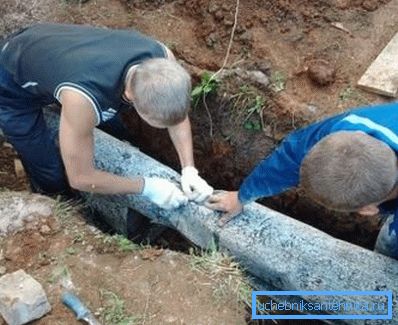
The need for insulation and pipe insulation
The system of water supply and sanitation throughout the entire period of its operation is at risk of various failures due to the influence of negative factors of the surrounding environment.
The question of whether it is necessary to warm sewer pipes is decided on the basis of the climatic conditions of the area where construction is carried out, as well as the technology used in the construction of sewage.
As is known, the sewage disposal system is of two types: external and internal.
The method of pipe insulation also depends on the place of pipe laying:
- Domestic sewage. Pipe insulation made of polyethylene foam or other similar materials is used when parts of the pipeline pass in unheated rooms or basements. In addition, it does not hurt to warm the system in places where the central vertical riser reaches the roof of the house (especially in the absence of an attic or an attic). Another reason is the reduction of the noise level that the water flowing through the system creates.
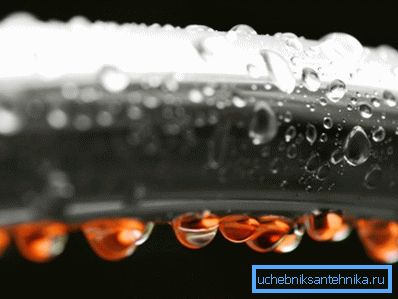
- External sewage. Here there is an instruction that the insulation of pipes of this system should be made to protect the drainage network from freezing and prevent moisture condensation that causes corrosion on metal fittings and other similar elements.
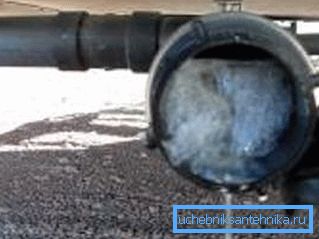
Correctly carried out installation of insulation allows:
- extend the life of the sewer system;
- reduce maintenance costs;
- avoid breakdowns and gusts of the pipeline;
- eliminate unpleasant noise in the drain system.
Note! In some cases, the lack of insulation can lead to a complete inoperability of the drainage network. For example, if the external pipeline is insufficiently deep, ice may form in it and it will be impossible to use sanitary fittings.
Materials used
In order for the selected insulation material to fulfill its function, it must meet certain requirements:
- have a low thermal conductivity;
- to be moisture resistant (water, impregnating insulation, negates its insulating properties).
When it is necessary to protect pipes of large size, sheet material is used, which is sold in rolls.
If it is required to insulate pipes of small diameter, special flexible shells of various shapes are well suited. They are provided with a cut, have a pre-calculated wall thickness and fit the pipeline as tight as possible.

The use of pre-made insulating tubes has many advantages:
- The resulting insulation is sealed and effectively protects the pipe from cold outside air;
- the shell is very durable and can withstand various mechanical effects;
- the pipe has an aesthetic appearance;
- insulation is easily and quickly mounted without the use of additional equipment;
- the material can be reused if necessary.
Polyethylene foam
This insulator, thanks to a special internal structure (air bubbles enclosed in a dense thin-walled shell) perfectly protects the pipes from cold, and you - from noise produced by the sewage system. There are many varieties of this material, which are distinguished from each other by price and some other minor parameters.
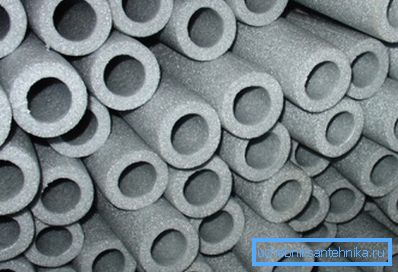
Let us dwell in more detail on the advantages provided by the insulation of pipelines with Termaflex polyethylene foam pipes:
- provides a high degree of isolation of pipelines from the effects of negative ambient temperature;
- prevents the formation of condensate and does not absorb moisture, which helps protect the pipelines or their metal parts from corrosion;
- absorbs vibrations, shocks and noise, thereby increasing the comfort of using the sewer system;
- made without the use of freon, because it does not have a negative impact on human health and the environment;
- it is resistant to mechanical impact, and also does not collapse at hit on it of oil, gypsum, cement, lime and so on;
- easy to assemble and remove; tubes can be reused;
- keeps the technical characteristics throughout all term of operation.
Available in the form of tubes with an internal diameter of 7 to 114 mm. The thickness of the walls is from 6 to 20 mm. To protect pipelines of larger diameter, sheet or roll material is used. It may additionally have a foil or adhesive layer.
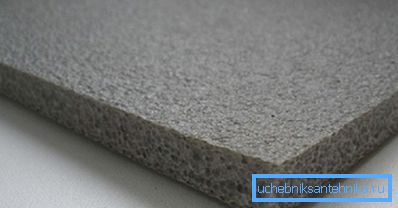
Tip! Tubes of polyethylene foam can be used to protect against corrosion of many other things. For example, putting these parts on the frame of the bike, you can easily protect it from the appearance of corrosion.
Foamed rubber
This type of heat insulator has all the properties of polyethylene, but it has greater elasticity. The most common insulation pipelines products from foamed rubber Armofleks.
The material has many undeniable advantages:
- can be operated in a wide range of temperatures (from - 200 to + 175 degrees Celsius);
- has high flexibility and elasticity that facilitates and accelerates installation;
- durable;
- possesses the increased fire resistance, does not sustain combustion;
- economical - allows repairing the pipeline in case of an accident without destroying the thermal insulation coating.

Conclusion
The use of polyethylene foam or rubber helps not only protect pipes from ice formation. This prevents the formation of moisture, reduces noise, prevents the formation of rust. As a result, the life of the sewer system is increased, saving you money.
For more information about the insulation of pipelines can be found in the video in this article.